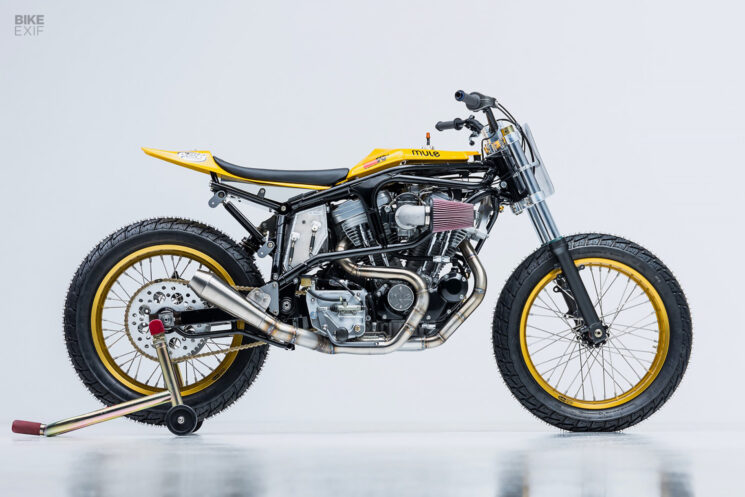
Flat track racing is a sport that combines speed, skill, and sheer audacity. Riders navigate an oval dirt track, sliding their motorcycles around corners in a controlled drift. It’s a sport with deep roots in American motorcycling culture, and it’s known for its simplicity and raw intensity. But for some builders, the appeal lies not just in racing but in creating the perfect machine to do so. One such builder is Richard Pollock, better known as “Mule,” who has become a legend in the flat track racing world for his custom-built motorcycles.

Mule’s passion for flat track racing began as a personal obsession, fueled by his love for motorcycles and his desire to push the boundaries of what a bike could do on the dirt. Over the years, he has built a reputation for crafting some of the most beautiful and functional flat track racers in the world. His creations are known for their clean lines, impeccable craftsmanship, and the kind of performance that wins races.
One of Mule’s most ambitious projects was the creation of the ultimate Hooligan flat track race bike. Hooligan racing is a subgenre of flat track racing that has gained popularity in recent years. It’s a throwback to the early days of the sport when riders would race their street bikes on dirt tracks. Hooligan bikes are typically heavier and less purpose-built than professional flat track machines, which adds an extra element of challenge—and fun—to the races.
Mule set out to build a Hooligan bike that would be both competitive on the track and true to the spirit of the sport. He started with a Harley-Davidson Sportster, a popular choice for Hooligan racing due to its robust engine and classic styling. But Mule wasn’t content with just modifying the stock bike. He wanted to create something truly special.
The first step was to strip the Sportster down to its bare essentials. Mule removed everything that wasn’t absolutely necessary for racing, including the heavy stock exhaust, bulky fenders, and any superfluous electronics. What remained was a lean, mean racing machine.
Next, Mule focused on the bike’s suspension and handling. Flat track racing demands a delicate balance of stability and agility, so Mule upgraded the front forks and rear shocks to high-performance units designed specifically for flat track racing. He also lowered the bike’s center of gravity and fine-tuned the frame geometry to improve cornering.
The engine was another area where Mule applied his expertise. The Sportster’s V-twin engine is known for its torque, but Mule wanted more power and better throttle response. He rebuilt the engine with high-performance parts, including a custom camshaft, lightweight pistons, and a freer-flowing intake and exhaust system. The result was an engine that could deliver blistering acceleration while still being reliable enough for the rigors of racing.
Mule’s attention to detail extended to every aspect of the bike, from the custom paint job to the hand-fabricated aluminum tank and seat. The final product was a bike that looked as good as it performed—a true work of art on wheels.
When Mule’s Hooligan flat track racer made its debut, it quickly became the talk of the racing community. Riders and fans alike marveled at the bike’s performance and its unique blend of old-school style and modern engineering. For Mule, the project was a labor of love, a testament to his skill as a builder and his passion for the sport of flat track racing.
In the end, Mule’s ultimate Hooligan flat track bike wasn’t just a race bike; it was a symbol of what can be achieved when craftsmanship, creativity, and a love of motorcycles come together. Whether tearing up the dirt on the track or sitting on display in a garage, Mule’s creation is a reminder of the enduring appeal of flat track racing and the endless possibilities of motorcycle customization.
Leave a Reply